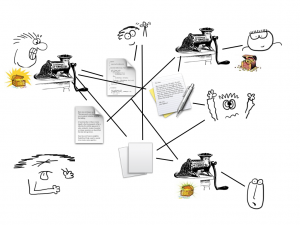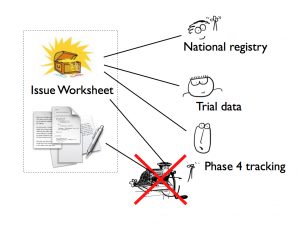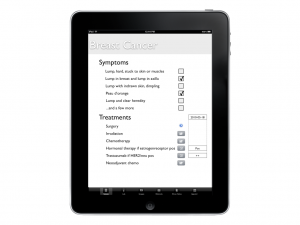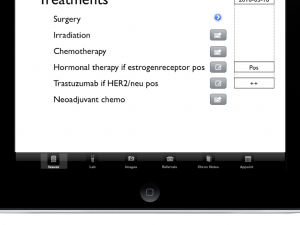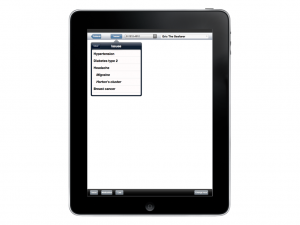I’m just copying a post here I just did to a closed forum for CISSPs.
A couple of days ago, I had to create a death certificate in Cosmic, the EHR system produced by Cambio Healthcare Systems and used in many provinces of Sweden and increasingly abroad.
So, I opened up the records for the patient, created a new death certificate form and filled it in. Printed it out, since it needs to go the paper route to the IRS (in Sweden, they handle the population registry). Then, just to make sure my data matched the EHR entry I made a few days before, I opened up the form again and discovered four different entry fields had changed after I saved. Two adress fields were blanked, my “place of employment” was changed to “Summer house” (part of another field I had filled in) and finally, my telephone number I had added was blanked out. I corrected the fields and resaved, same thing happened again. Did it three times, same thing. I never signed the document, of course, instead having a secretary scan in my paper form, which was correct, and have that put in the EHR. The erroneous form remains there, but unsigned.
I pointed out this severe bug to the IT department, and the reply I just got went into some depth explaining to me what the different fields were supposed to contain, but they didn’t touch at all on the hairraising fact of changing the documents behind my back. That’s apparantly entirely ok for them.
In this scenario, I never signed, but if I had done that, nothing would have played out differently. The scary thing is that the normal workflow is to fill in a form, any form, print it out (optionally), then sign it, which flags it as signed and saves it in one operation. You never see what actually gets saved with your “signature” on it. We’ve had a number of bugs before, where dates were changed in sick leave forms, a number of crucial fields erased and so on, so this is just the last in a long series of such bugs.
This system, the largest on the Scandinavian market, uses Acrobat Reader (yes, you read that right, *Reader*) to fill in forms. So they prepare the form data in the background, launch the Reader, lock it down modally since they can’t handle the interactions right, then let you edit and save. The “save” and “signature”, even “delete” buttons are implemented *inside* the document form since they run modally. Just to give you an idea of the “leading edge technology” we’re talking about here.
The forms as such are designed by the end-user organisation, so the problem is in two parts: Cambio enables a sloppy workflow and does not respect the immutability of signed data in their application. The end-user organisation does not test new forms for problems.
So, my issues with all this are:
1. This product has passed CE approval. So where is the systems test? These problems are trivial to find before rollout. Not to mention that I, and others, have pointed these form problems out in public since at least two years. What’s the point of the CE, anyway?
2. If Cosmic is able to change the content of forms behind my back, why isn’t this recorded in a log? There is no way I can show after the fact that the form contains stuff I never wrote, even if I would be able to remember what I wrote and this has caused much consternation before with the sick leave forms. Why isn’t audit trailing of this a requirement from the user organisation or from the CE protocol?
3. Why does the system not warn me or show me the changed information during or after signature? It bloody well warns me for everything else I don’t need warnings for. A typical Windows app, if you get my drift.
4. Why doesn’t the “signature” mean anything? It’s simply a flag set in the system with no functional binding to the information. They’re in the process of rolling out smart cards now; I have one. You stick them into a slot on the keyboard to sign in, at least that’s the idea (doesn’t work, they don’t have the trusted root installed…). But that’s for Windows login. The “signature” in the EHR remains a dumb flag AFAIK.
Meanwhile, the law and regulations governing medical practice make a huge deal out of these signatures. We *have* to sign stuff in a timely fashion and can be sanctioned if we don’t. And if we do sign, we’re held to what we sign, legally, morally, ethically. Our careers can be held hostage by a stupid flag in a stupid database record, designed by an irresponsible designer, and implemented by an agile and equally uninformed coder.
My question is this: is this shitty state of affairs, this total ignorance of what the law and regulations say, this total lack of interest in quality and consistency in application design and implementation, something common to EHR systems everywhere? Is this laissez-faire attitude something you actively try to combat as security professionals if you work in the medical field, and if not, why not?
Or, provocatively, I’ve repeatedly heard on this list (it’s a while since last time) that doctors don’t respect security in EHR systems, but now my question is this: does anyone else? It seems not.
And finally, WTF is the point of the CE approval…? I’ve seen all the cynical answers, now I want a real answer somehow.

